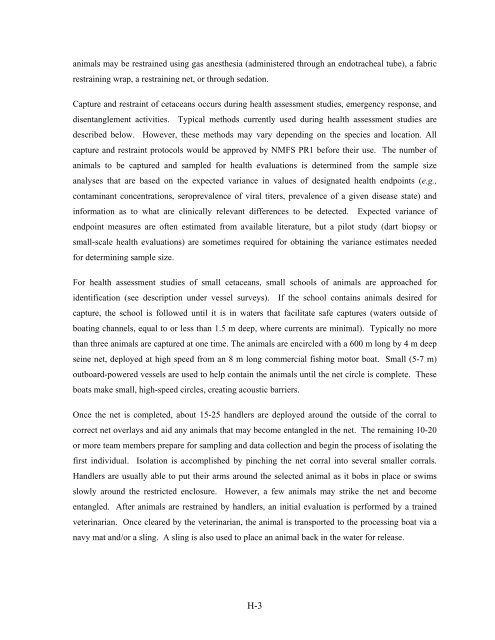Volume III, Appendices EM - National Marine Fisheries Service ...
Volume III, Appendices EM - National Marine Fisheries Service ...
Volume III, Appendices EM - National Marine Fisheries Service ...
Create successful ePaper yourself
Turn your PDF publications into a flip-book with our unique Google optimized e-Paper software.
animals may be restrained using gas anesthesia (administered through an endotracheal tube), a fabric<br />
restraining wrap, a restraining net, or through sedation.<br />
Capture and restraint of cetaceans occurs during health assessment studies, emergency response, and<br />
disentanglement activities. Typical methods currently used during health assessment studies are<br />
described below. However, these methods may vary depending on the species and location. All<br />
capture and restraint protocols would be approved by NMFS PR1 before their use. The number of<br />
animals to be captured and sampled for health evaluations is determined from the sample size<br />
analyses that are based on the expected variance in values of designated health endpoints (e.g.,<br />
contaminant concentrations, seroprevalence of viral titers, prevalence of a given disease state) and<br />
information as to what are clinically relevant differences to be detected. Expected variance of<br />
endpoint measures are often estimated from available literature, but a pilot study (dart biopsy or<br />
small-scale health evaluations) are sometimes required for obtaining the variance estimates needed<br />
for determining sample size.<br />
For health assessment studies of small cetaceans, small schools of animals are approached for<br />
identification (see description under vessel surveys). If the school contains animals desired for<br />
capture, the school is followed until it is in waters that facilitate safe captures (waters outside of<br />
boating channels, equal to or less than 1.5 m deep, where currents are minimal). Typically no more<br />
than three animals are captured at one time. The animals are encircled with a 600 m long by 4 m deep<br />
seine net, deployed at high speed from an 8 m long commercial fishing motor boat. Small (5-7 m)<br />
outboard-powered vessels are used to help contain the animals until the net circle is complete. These<br />
boats make small, high-speed circles, creating acoustic barriers.<br />
Once the net is completed, about 15-25 handlers are deployed around the outside of the corral to<br />
correct net overlays and aid any animals that may become entangled in the net. The remaining 10-20<br />
or more team members prepare for sampling and data collection and begin the process of isolating the<br />
first individual. Isolation is accomplished by pinching the net corral into several smaller corrals.<br />
Handlers are usually able to put their arms around the selected animal as it bobs in place or swims<br />
slowly around the restricted enclosure. However, a few animals may strike the net and become<br />
entangled. After animals are restrained by handlers, an initial evaluation is performed by a trained<br />
veterinarian. Once cleared by the veterinarian, the animal is transported to the processing boat via a<br />
navy mat and/or a sling. A sling is also used to place an animal back in the water for release.<br />
H-3
















